Maksim Ablameiko, Senior BI & Analytics Consultant at ACBaltica
SAP has a long and rich history in data analytics and warehousing, from the introduction of SAP BW (Business Warehouse) in the late 1990s to the development of the in-memory platform SAP HANA, and on to modern cloud-native solutions such as SAP Datasphere. Throughout this time, SAP has provided robust modelling frameworks, semantic layers and comprehensive analytical tools, including SAP BusinessObjects and SAP Analytics Cloud (SAC).
The company's strategy has evolved in response to market changes. Today, SAP is taking the next step with SAP Business Data Cloud (BDC), which combines the company's best data and analytics solutions to bring everything together in one place. This approach helps organizations simplify their data landscapes, improve governance, and unlock real business value without creating more complexity.
In this article, we will explore how different parts of the SAP BDC work together, from data products and in-app insights to zero-copy integration, to see how they can be used together.
What is SAP Business Data Cloud (BDC)?
SAP BDC is the next version of SAP's data foundation. It combines data integration, storage, analytics, and AI into one platform. It helps organizations connect and use data from both SAP and non-SAP systems through a governed semantic layer.
SAP BDC is a comprehensive data and analytics suite that combines several key SAP solutions:
- SAP Datasphere – provides data warehousing, integration, and consolidation with rich business semantics.
- SAP Analytics Cloud – delivers advanced business intelligence, reporting, and planning.
- BW 7.5 and SAP BW/4HANA Private Cloud Edition – supports existing BW environments and ensures a smooth transition to the cloud.
- SAP Databricks – powers data engineering, machine learning, and advanced analytics workflows within BDC.
All these components come pre-integrated as a single software-as-a-service (SaaS) offering, working together seamlessly.
SAP Datasphere
SAP Datasphere is the data foundation of SAP BDC. It is a cloud-based SaaS solution that enables organizations to connect, integrate, and manage data from SAP and non-SAP sources while preserving its business context and meaning. This gives you a single, unified view of your data in ready-to-use sets. You can use these data sets directly in SAP Analytics Cloud (SAC) for reporting and planning, or for machine learning, simple dashboards, and other BI or SQL tools.
SAP Datasphere: Business scenarios
SAP Datasphere supports different ways of working with data, depending on how much flexibility your business needs.
Out-of-the-box scenario
In this setup, SAP Datasphere provides ready-to-use data models that form the foundation for Insight Apps. These models are kept in a secure, SAP-managed space that controls who can access the data and what they can see. Datasphere works as a data preparation and security layer, getting data ready before it’s shown in Insight Apps.
This setup works with SAP systems like S/4HANA, Ariba, and SuccessFactors, so organizations can start analyzing trusted data right away.
Custom scenario
Sometimes, businesses need more flexibility than standard content allows. SAP Datasphere lets you create custom data models in a space you manage. You can combine SAP-managed, custom, or third-party data into unified models that match your specific needs. The platform also gives you control over data access. You can replicate data into Datasphere or use virtual consumption (data federation), balancing performance and governance.
SAP Databricks
Databricks serves as the advanced analytics and AI/ML layer, letting data scientists and analysts build, train, and deploy predictive models directly on business data. It provides a familiar environment with support for coding, data transformations, machine learning workflows, and Python or SQL notebooks powered by Apache Spark.
Teams can also use tools like MLflow to track model performance and manage experiments, making Databricks a powerful platform for modern data and AI teams.
Key capabilities of SAP Databricks within BDC:
- Full machine learning lifecycle management from experimentation to production, with support for generative AI and LLMs.
- Built-in data science workspaces and visualization tools for collaborative analytics.
- Powerful data ingestion and transformation features for engineering and preparing data at scale.
- Centralized governance for all assets, including structured and unstructured data, ML models, notebooks, dashboards, and files, managed through Databricks Unity Catalog.
How Databricks and Datasphere work together
SAP Datasphere and Databricks work together seamlessly. Datasphere specializes in connecting and organizing data from SAP and non-SAP systems to create trusted, ready-to-use data products. Databricks adds the power of data engineering, AI and machine learning to process and analyze that data on a large scale.
Their integration uses zero-copy sharing, meaning data doesn't need to be moved or duplicated. It is shared securely between the two systems in real time. For instance, data prepared in Datasphere can be used in Databricks to build predictive models, with the results being sent back to Datasphere as new data products for reporting and planning purposes.
SAP Analytic Cloud (SAC)
SAP Analytics Cloud (SAC) forms the front-end layer of SAP Business Data Cloud. It brings together business intelligence, planning, and predictive analytics in a single interface. SAC connects directly to SAP Datasphere via live connections, ensuring that data security and access rules remain intact. Users can build interactive dashboards, run real-time reports, and create forecasts without having to copy data.
In terms of planning, SAC provides features like versioning, data actions, allocations, and workflows, enabling finance and operations teams to plan, analyze, and report within the same environment.
Insight Apps and Data Products in SAP BDC
Beyond bringing together its core components, BDC also provides pre-delivered business content. This content is ready to install and use, but much more advanced than traditional SAP content. It includes Insight Apps (also called Intelligent Applications) and Data Products.
These pre-built solutions solve key business problems. In the past, creating dashboards or analytical reports was time-consuming: teams had to define metrics, prepare data, build models, design visuals, and set up security before insights could be used. With Insight Apps, however, everything is pre-built and ready to go. Simply install the app, assign user roles, and start analyzing. Similarly, Data Products provide secure, reusable datasets that are ready to use, making it easy to share and analyze trusted data across the organization.
Insight Apps
Insight Apps are ready-made analytical applications that you can start using immediately. Each app comes with everything you need, including data connections, pre-built models and SAP Analytics Cloud stories. Installing them is almost as easy as downloading an app to your smartphone.
BDC automatically sets up all the technical components behind the scenes, including semantic models, data flows, security roles and analytic views, so setup is quick and straightforward. You can start using the app right away.
Insight Apps are available across all major business areas, and the catalogue is constantly growing, providing organizations with an ever-increasing range of pre-built, ready-to-use insights.
Data Products
Data products are another key part of BDC. These are ready-to-use datasets that include business context and meaning. These datasets can be shared and reused both within and outside of BDC, which makes data management easier and more scalable.
Main types of Data Products
-
SAP-managed – delivered by SAP and ready to use for various business domains (e.g., customer, production, financial data).
-
Custom-managed – created and maintained within your own organization (e.g., specific operational metrics).
-
Third-party – developed by SAP partners or external providers and available for integration (e.g., industry benchmark datasets).
BDC implements the data mesh concept, treating data as reusable, shareable assets focused on the business that make management easier and create real business value.
AI enablement
SAP BDC helps organizations prepare for AI by providing a solid, well-governed data foundation on which to train AI and machine learning models. High-quality, well-managed data is essential because AI is only as good as the data it is based on.
BDC includes several components that enable AI-driven insights:
-
Joule – SAP’s built-in AI assistant that lets users interact with their data using natural language. Once your data is loaded into BDC and visualized in reports, you can simply ask Joule questions and get answers based on your actual business data.
-
Databricks – the industry-standard platform for machine learning and AI workloads. It allows you to use BDC data products, such as customer or sales data, to train predictive or classification models, and even large language models (LLMs). The results can then be used directly in reporting and planning within BDC.
-
SAC – provides built-in predictive and simulation capabilities, including forecasting, relationship analysis, and what-if scenario modeling.
Together, these tools make BDC a comprehensive platform for connecting trusted data with advanced AI and machine learning capabilities.
BW 7.5 and BW/4HANA Private Cloud Edition (PCE)
The BW Private Cloud Edition (PCE) incorporates both the SAP BW 7.5 and SAP BW/4HANA solutions. Within BDC, it protects existing BW investments while providing an easier path to the cloud. BW PCE is like a bridge between old BW systems and the new BDC world. It helps to change to cloud-based data management bit by bit and without too much risk.
Many organizations still rely on BW for critical ETL processes, data extraction, ABAP logic, and process chains. PCE provides a managed environment in which these workloads can continue without disruption.
At the same time, BW PCE integrates with SAP Datasphere, enabling you to publish curated data products from BW for enterprise-wide sharing and use in SAC.
Practical application of BDC for working capital management and reducing DSO
Rising Days Sales Outstanding (DSO) poses liquidity risks to modern finance teams. Using BDC alongside SAP S/4HANA, SAP Datasphere and external analytics tools can help to identify these risks and predict payment delays, thereby improving accounts receivable management.
Detecting early warning signals in S/4HANA
Effective management begins with the timely identification of risks. For instance, CFOs can use the SAP S/4HANA Public Cloud interface to monitor increasing DSO and overdue receivables.
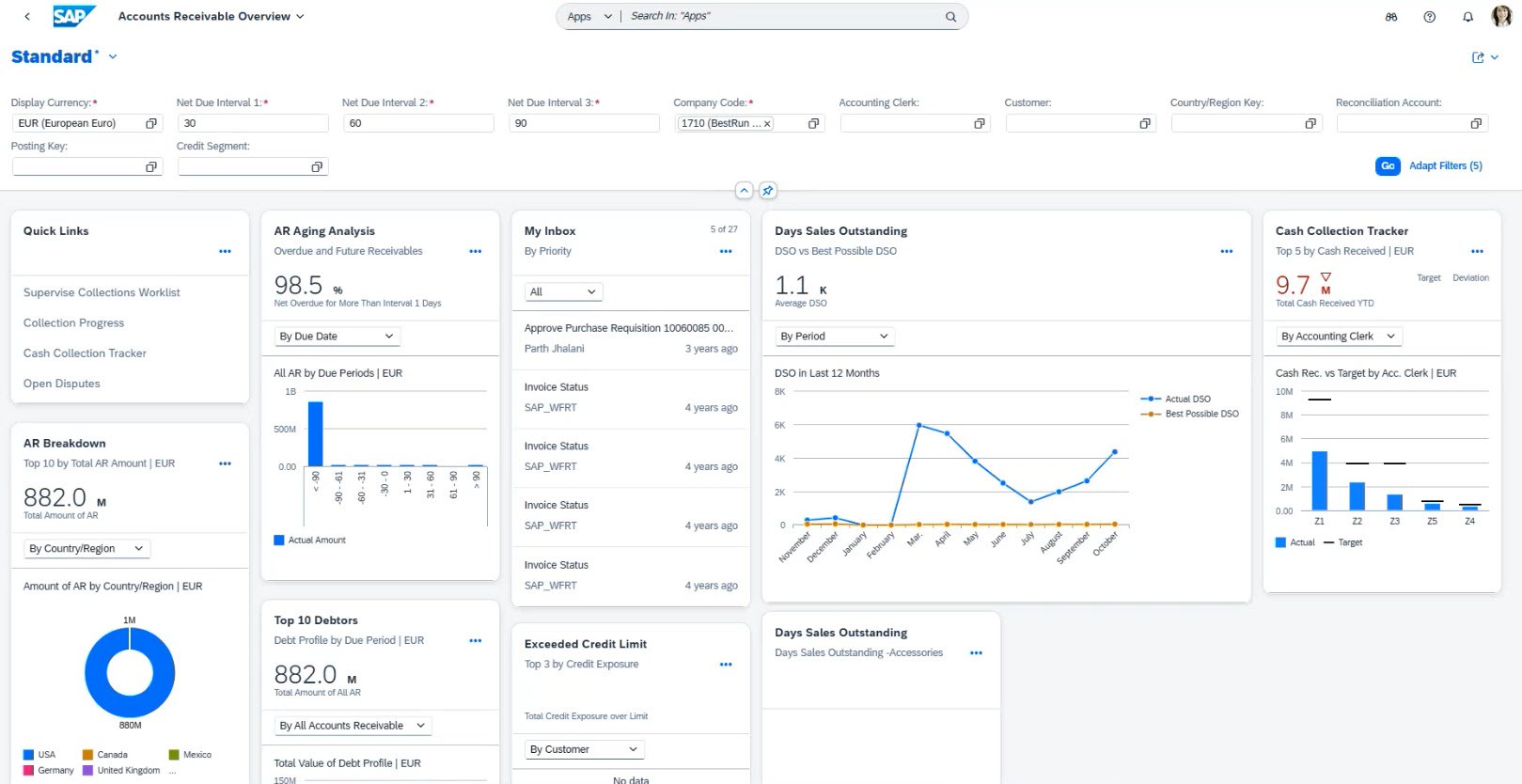
Standard dashboards allow the identification of high-risk customers and trends in delayed payments.
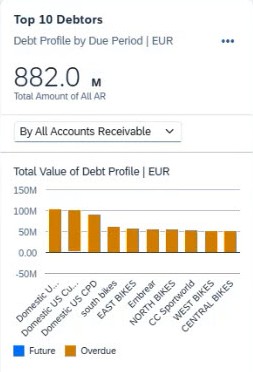
While these insights provide an initial understanding, deeper analysis requires additional data processing.
Using the Working Capital Insight Application
For deeper insights, the Working Capital Intelligent Application can be deployed via the BDC Cockpit. This application includes data models and analytics to help finance teams track cash flow trends and payment patterns, as well as analyse receivables at the customer level. It also provides advanced KPIs and metrics to support better financial decision-making.


In the Accounts Receivable (AR) tab, finance teams can track and analyse rising DSO trends by customer. The report categorises receivables as either overdue or non-overdue, making it easier to identify critical areas that require attention.
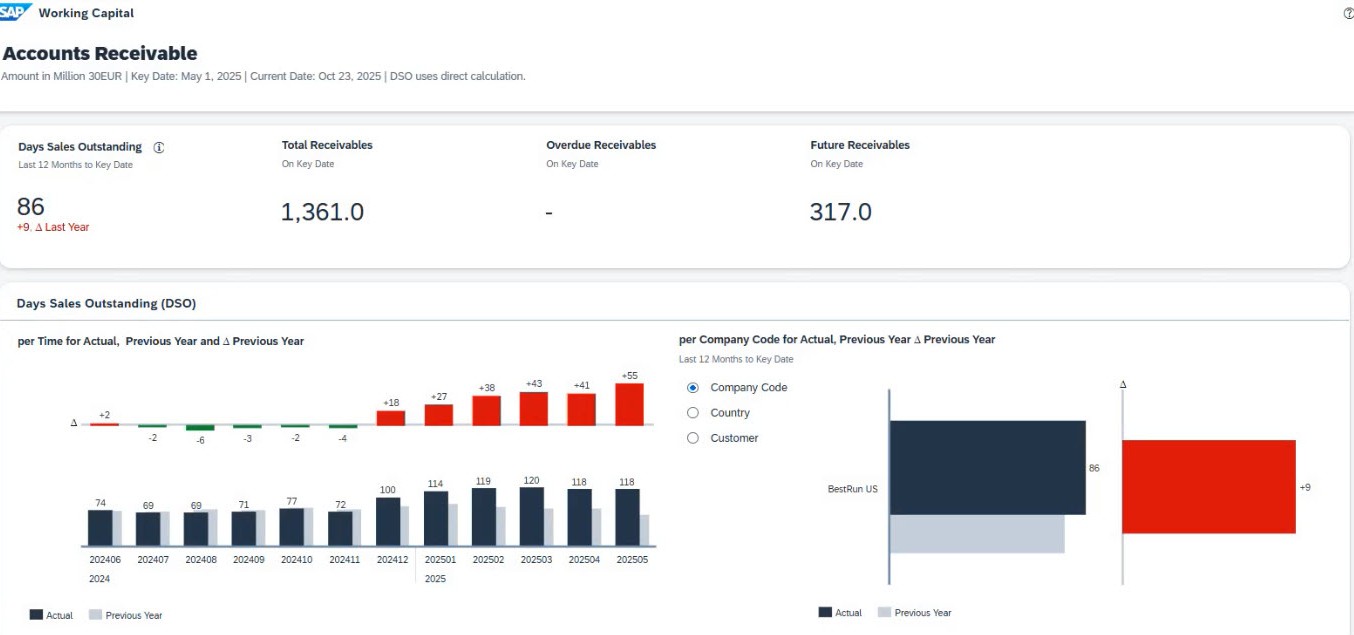

While these insights show what’s happening with receivables, they don't explain why DSO is increasing. It is also important to be able to predict whether payment delays are likely to occur. In order to understand this, organizations need to combine data from different sources and apply predictive analytics.
Data enrichment and predictive payment delay analysis
To achieve this, accounting data serves as the analytical foundation. In this example, the data originates from the Entry View (Journal Entry) in SAP S/4HANA.

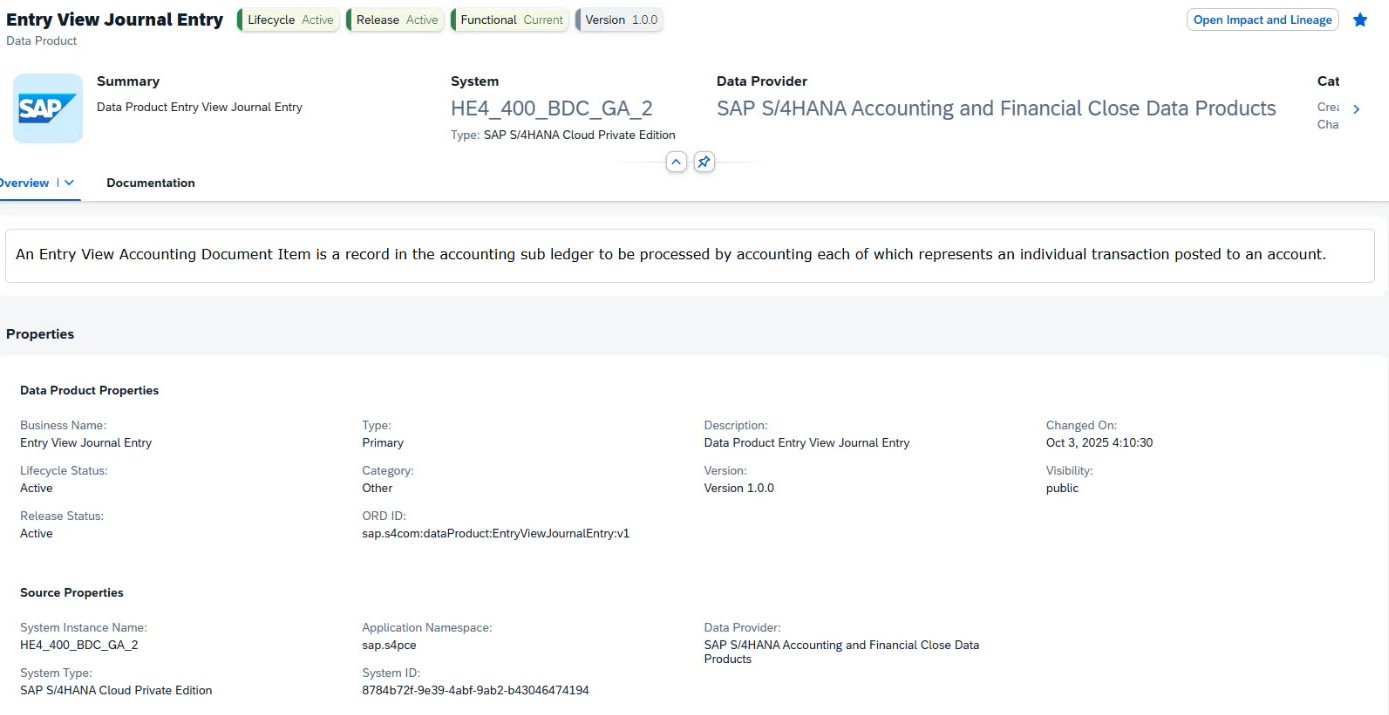
The Entry View (Journal Entry) is a unified view of all accounting postings in S/4HANA. It captures every financial transaction in a consistent structure, including document numbers, posting dates, company codes, payment terms, due dates, and customer information. This makes it the central source for both operational and analytical finance processes.
In SAP Datasphere, the Journal Entry data is made available as a Data Product, so it can be shared securely and consistently across connected systems. From there, it goes to Databricks, where it is used in a machine learning workflow.
In Databricks, a regression-based machine learning model is trained on historical payment data to predict the likelihood and timing of payment delays for each invoice and customer. The workflow is organized through notebooks that handle data preparation, model training, and predictions. Model experiments and metrics are tracked to ensure accuracy and transparency.

Once the model has generated predictions, the enriched dataset, including predicted payment dates and delay probabilities, goes back to SAP Datasphere as an enhanced data product. This makes it easy to use the predictive insights in SAP Analytics Cloud (SAC) dashboards.
Accessing predictive data in SAP Datasphere

To gain a comprehensive understanding of customer payment behaviour, SAP Datasphere enables you to combine predictive data with information from other sources. Alongside AR data from S/4HANA and Databricks predictions, organizations can incorporate historical customer payment data from SAP BW, customer risk segmentation from Google BigQuery, or data from any other source.
Combining these datasets strengthens the analytical context, helping to uncover patterns behind payment delays, customer risk factors, and long-term behavioural trends.
Building a unified data model in Data Builder
The consolidation happens in Data Builder, where a graphical view brings together all required datasets. This unified view becomes the core of an analytic model, including standard calendar and time-based associations. These associations add important semantics, like date hierarchies and attributes, enabling flexible reporting and drill-down capabilities.
Delivering insights through SAC
Once the analytic model is finalized, it becomes available for consumption in SAC.
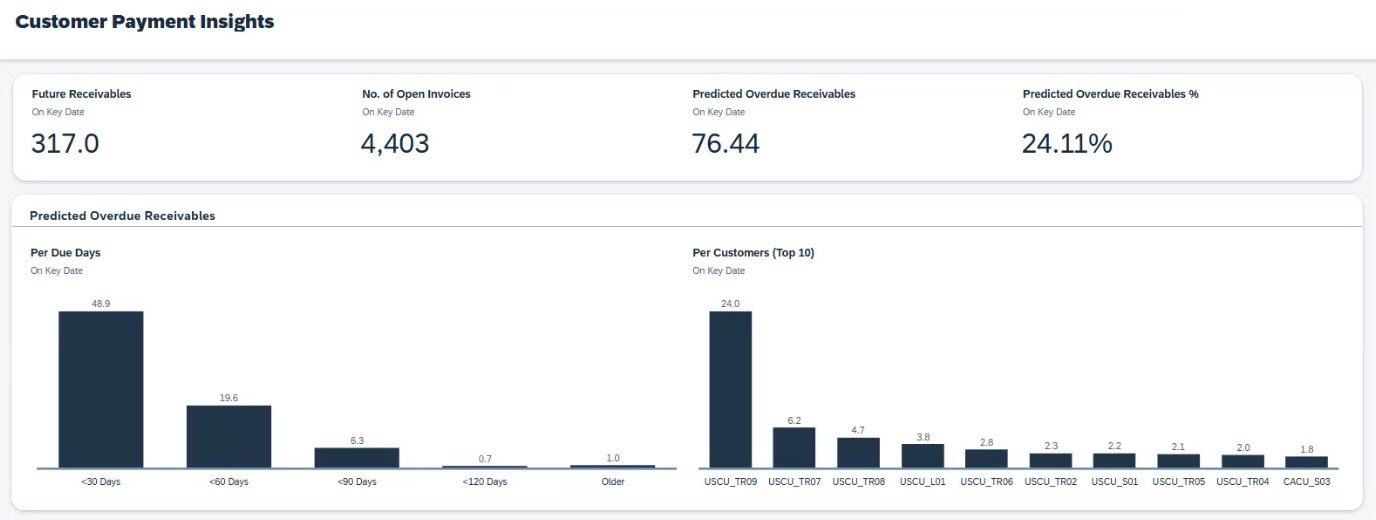

The enhanced report now shows a combined view of operational data, historical trends, and predictive insights.
With predictive payment dates included, finance teams can make more reliable cash flow forecasts and spot potential shortfalls earlier. Receivables teams can focus on customers with the highest predicted risk and take action before invoices become overdue, improving collection efficiency. Credit managers gain clearer insight into recurring late-payment patterns, allowing them to adjust payment terms or credit limits when needed.
Together, these capabilities help reduce DSO, lower liquidity risk, and enable a more proactive approach to managing working capital.
Extending the scenario with revenue forecasting
Organizations can also extend their analysis to revenue forecasting. By incorporating predicted payment behaviour into forecast models, finance teams can compare expected revenue with revenue adjusted for predicted delays.
These predictions are often more accurate than traditional estimates because they reflect actual customer payment patterns rather than ideal contractual terms.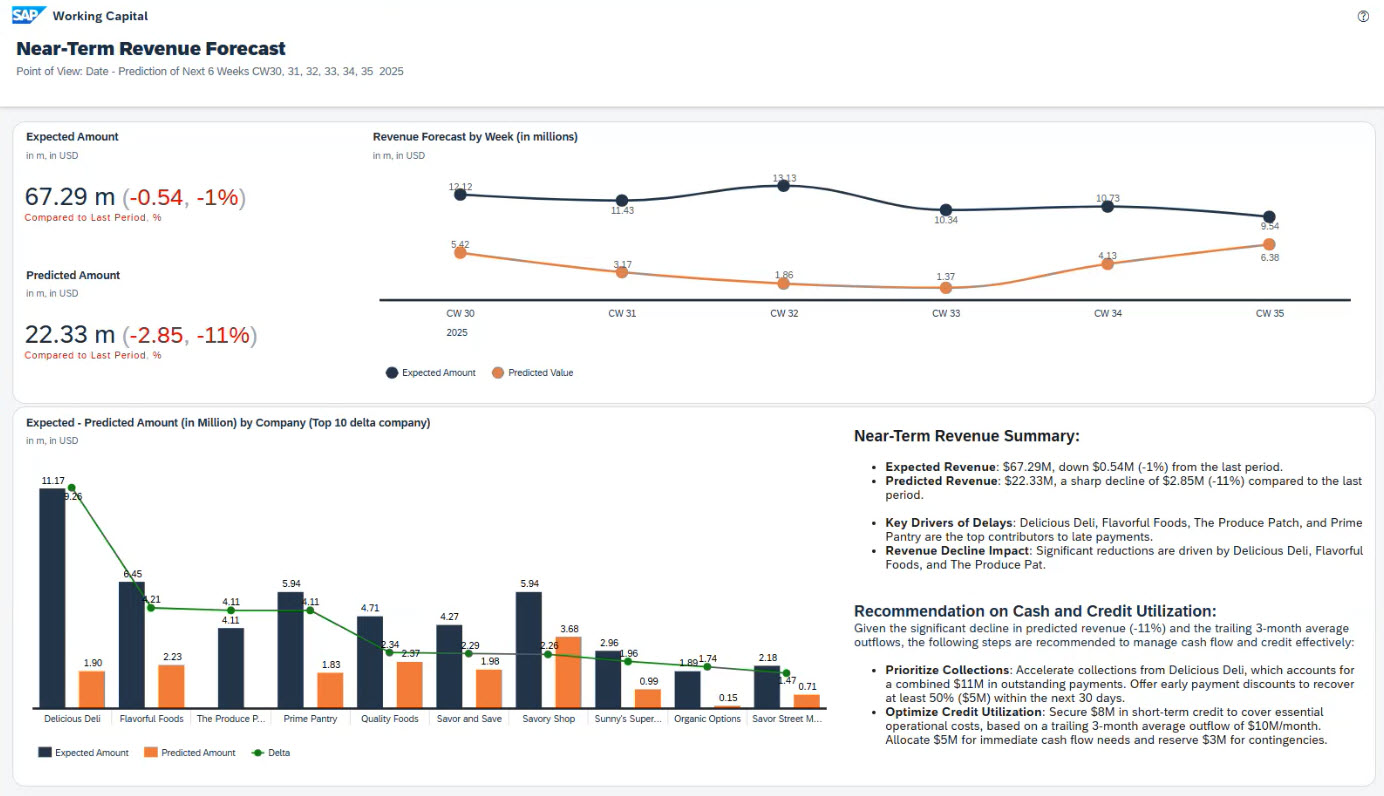
This approach provides a more realistic view of future revenue and helps to identify potential risks earlier. Consequently, financial planning becomes more data-driven, providing finance leaders with clear visibility of expected cash inflows and areas requiring corrective action.
Key business benefits of SAP BDC
SAP Business Data Cloud (BDC) unifies data management, analytics, and AI capabilities in a single, intelligent platform. It connects SAP Datasphere, Databricks, and SAP Analytics Cloud to deliver trusted insights and accelerate data-driven transformation. Its key advantages include:
-
End-to-end data management – provides trusted, up-to-date data with full business context, governance, cataloging, and AI/ML tools all in one place.
-
One platform, zero glue – eliminates the need for complex integrations. All components are designed to work seamlessly together under one vendor.
-
Built for SAP data – natively handles SAP data and logic, removing the need for custom ETL or replication and reducing total cost of ownership.
-
Integration over “infinite flexibility” – unlike generic data warehouses that require heavy customization, BDC simplifies integration, especially for SAP systems.
-
Open and cost-efficient – uses open standards and scalable object storage (including Databricks) for efficient, economical processing and growth.
-
Faster ROI – delivers business value more quickly than fragmented data stacks that combine separate data warehouse, reporting, and planning tools.
By providing a unified data foundation for analytics, planning, and AI, SAP Business Data Cloud helps organizations make smarter decisions, streamline operations, and move confidently toward an intelligent, AI-ready enterprise.

